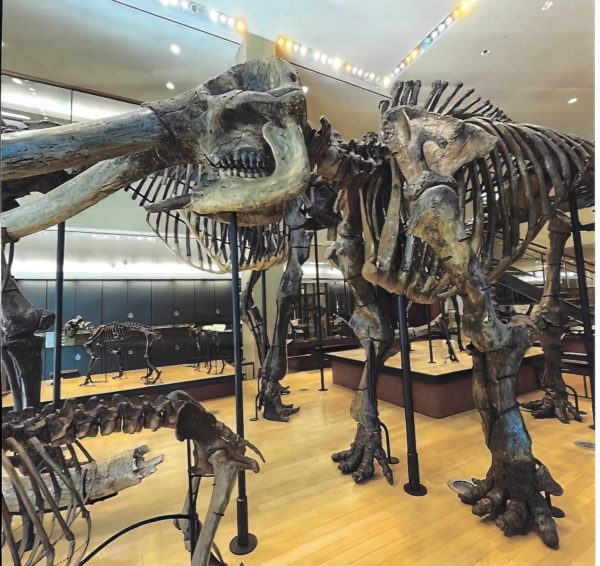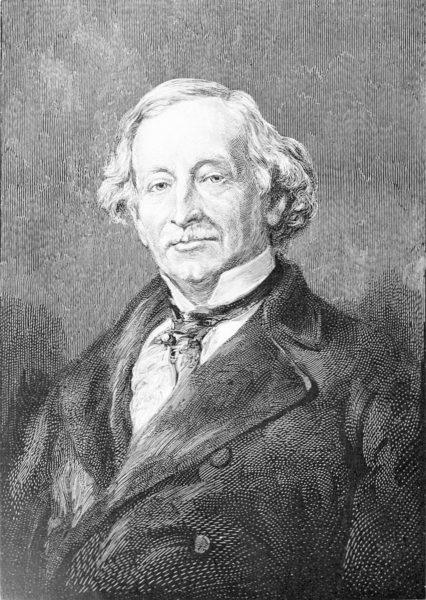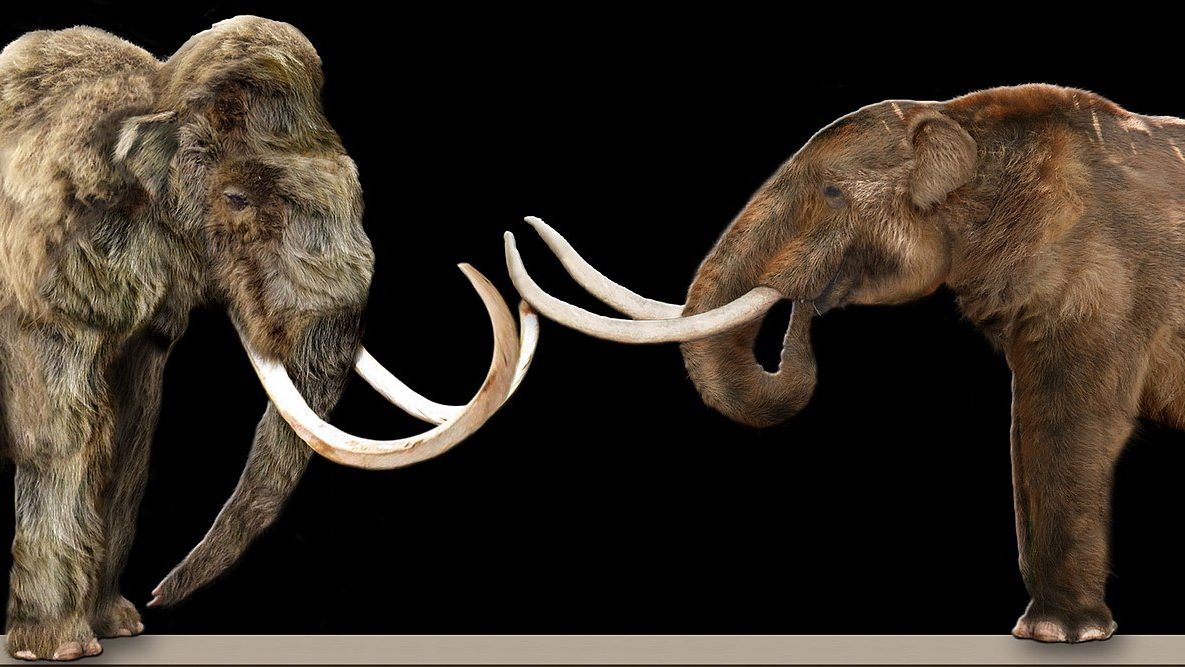Wooly Mammoth (left) & American Mastodon (right) By Dantheman9758 at the English Wikipedia
The DHF is proud that we have artifacts found on Datha Island in the early ALCOA days that date back thousands of years. For example, in the display on the southwest wall of the History & Learning Center is a Paleo Indian Point that dates to 10,000 B.C. However, many have explored our area over the centuries. I recently learned from a young lady in Massachusetts that Charles Upham Shepard found an older and much larger item on St Helena Island in the 1800s; an American mastodon (Mammoth americanum) from the late Pleistocene era! This intact skeleton, found next door, pushes back our knowledge of this area by several thousand years, to at least 12,000 B.C.
Just Imagine
At about the time Dr. Lewis Reeve Sams, Jr. (1810-1888) (oldest son of Lewis Reeve Sams) was managing his sea island cotton plantations next door on Polowana and Saint Helena Islands, professor and scientist Charles Upham Shepard (1804 – 1886) was exploring the minerals and fauna of Saint Helena Island.
Just imagine if Dr. Sams got up one morning, took a boat over to Beaufort, and saw this headline in the Beaufort Gazette,
“Amidst the picturesque beauty of Saint Helena Island, a tantalizing glimpse into the Pleistocene era emerged—a magnificent mastodon, carefully extracted from its ancient slumber.”
Indeed the many planters in the area would have been a buzz from this news – if the discovery happened before the Civil War.
Charles Upham Shepard (b.1804 – d.1886)
Charles Upham Shepard was born in Rhode Island and educated at Brown University, Amherst College, and Yale University. He was a renowned scientist specializing in geology and mineralogy. Charles played a crucial role in advancing these fields and had a connection to South Carolina and Saint Helena Island through both his teaching and explorations for phosphate rock deposits.
Charles was a lecturer at Yale College from 1830 to 1847 and taught & lectured at Amherst College from 1845 until his death in 1886 (in Charleston!) He was a ‘snowbird’. In the colder months, he taught at the South Carolina Medical College (now MUSC) from 1834 to 1869, taking a hiatus during the Civil War years. His early years at MUSC overlap with Dr. L.R. Sams student days there, but I have no evidence they knew each other.
Shepard’s expertise in mineralogy and geology led to significant contributions in these fields. For example, his work on mineral specimens and research was vital in establishing the Beneski Museum of Natural History at Amherst College, where the Saint Helena Island mastodon ‘lives’ today. And his explorations before the war of phosphate rock deposits in the Southeastern U.S. would play a role in Beaufort’s resurgence in the later part of the 19th century – until the hurricane of 1893 wiped out the industry.


We have yet to determine precisely when he found or excavated the mastodon, but we know he taught in South Carolina before and after the Civil War. It may have been through his phosphate exploration in our area that Shepard discovered the mastodon. A paper published by the Carnegie Institution of Washington in 1922 mentions that the complete mastodon skeleton found by Charles U. Shepard on Saint Helena Island was at Amherst College by 1870. There was great interest in the 18th and 19th centuries in the Pleistocene era, partly due to our new nation wanting to outshine the old world and partly based on the mounting evidence that it marked the end of the Ice Age and the commingling of humans and fauna on this continent. Two interesting items from this period came to my attention.
First, President Thomas Jefferson was obsessed with mastodons (he first thought they were mammoths but later realized the difference.) Read the article below in sources about Thomas Jefferson. It gives you a sense of the debate going on at the time about whether any animal ever became extinct and, second if animals in the nascent United States could be larger than those in Europe. Together these views drove his passion for the Lewis & Clark expedition; one objective was to find mastodons!
Second, our blind spot for African wisdom. The enslaved people brought here, particularly in the 18th century, who were born in Africa, found mastodon teeth when preparing the land for planters. Scientists at the time did not know what to make of these unique, big rocks. The enslaved people told them they were elephant’s teeth. The enslaved people were closer to the truth than anyone realized.
The Pleistocene Era
The Pleistocene epoch lasted from 2.6 million to 11,700 years ago and was characterized by ice ages and significant fluctuations in sea levels. North and South America were not yet connected. The current consensus is that humans crossed into North America from Asia via a land bridge called Beringia, which eventually connected present-day Siberia and Alaska. The most widely accepted theory suggests that this migration occurred 15,000 to 20,000 years ago. There is evidence that showcases the diverse fauna that likely coexisted with early humans in the Lowcountry area.
Fossil evidence suggests that American Mastodon (mammoth americanum) & Columbian Mammoth (Mammuthus columbi) inhabited the region during the late Pleistocene. The discovery of remains, including bones and tusks, in South Carolina indicates their presence and coexistence with early humans.
Also here was the Giant Ground Sloth (Eremotherium), a large herbivorous mammal that roamed the Lowcountry area. Fossils of these creatures have been found in nearby states, such as Georgia, indicating that they could have inhabited our region of South Carolina during the same period.
The Dire Wolf (Canis dirus) was a large predatory mammal that also existed during the Ice Age. While there might not be direct documented evidence of dire wolves in the Lowcountry area of South Carolina, their presence is inferred based on their widespread distribution throughout North America during that time.
Museums in South Carolina
South Carolina is home to museums where mastodon exhibits can be found. The South Carolina State Museum in Columbia houses a Natural History Gallery showcasing the state’s geological and paleontological history. At the same time, the Charleston Museum in Charleston, the oldest museum in the United States, has lots of pieces of mastodons and a photo gallery of a 1937 excavation on Edisto Island.
Beneski Museum of Natural History at Amherst College
While the Beneski Museum primarily focuses on earth sciences and paleontology, it owes part of its collections and exhibits to Charles Upham Shepard. His extensive mineral collection was a foundation for the museum’s holdings, showcasing the region’s geological heritage and honoring Shepard’s contributions.
Conclusion
Thanks to an astute granddaughter in Massachusetts and her grandmother here on Dataw Island, we have rediscovered ‘our’ American Mastodon from Saint Helena Island, South Carolina, about 15,000 thousand years after it died, give or take a bit.
Jane Griffin’s granddaughter attends Amherst College and works at the Beneski Museum. The museum placard that caught her eye reads,
Mammut americanum
(American Mastodon)
St. Helena Island, South Carolina, USA
Late Pleistocene (~15,000 years ago)
C.U. Shepard, Collector
Sources
Shepard, Charles Upham (June 29, 1804 – May 1, 1886) in the South Carolina Encyclopedia. [https://www.scencyclopedia.org/sce/entries/shepard-charles-upham/]
[https://en.wikipedia.org/wiki/Mastodon]
Wooly Mammoth (left) & American Mastodon (right) By Dantheman9758 at the English Wikipedia, CC BY-SA 3.0, [https://commons.wikimedia.org/w/index.php?curid=4289640]
Wikipedia entry for Amherst Collage, Beneski Museum of Natural History
[https://en.wikipedia.org/wiki/Beneski_Museum_of_Natural_History]
Wikipedia entry for Pleistocene (Ice Age)
[https://en.wikipedia.org/wiki/Pleistocene]
[https://www.scencyclopedia.org/sce/entries/prehistoric-south-carolina/]
The Pleistocene of North America and Its Vertebrated Animals, From The States East of The Mississippi River and From The Canadian Provinces East of Longitude 95° by Oliver P. Hay, Associate of the Carnegie Institution of Washington, 1922
Thomas Jefferson Built This Country On Mastodons.
[https://www.atlasobscura.com/articles/thomas-jefferson-built-this-country-on-mastodons]
Discover Lewis & Clark: Mastodons.
[https://lewis-clark.org/sciences/geology/paleontology/mastodons/]


